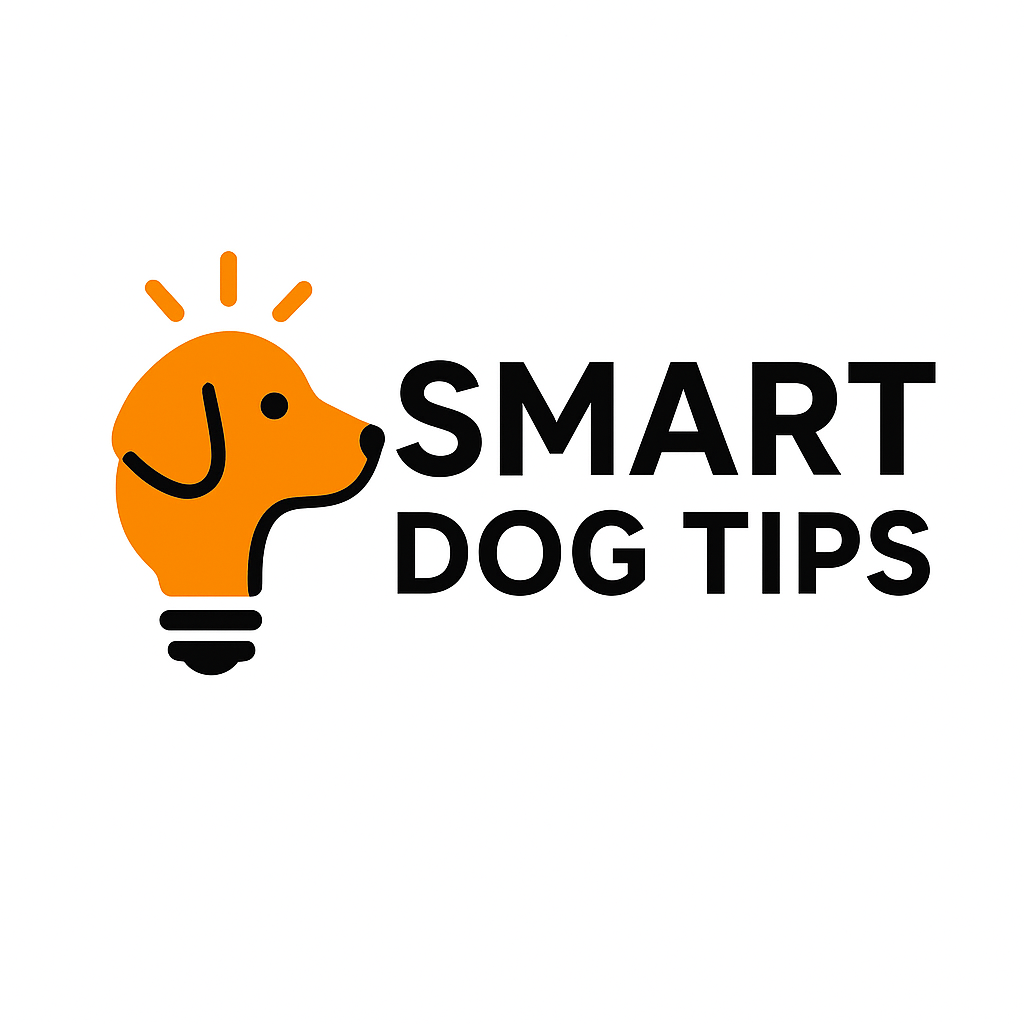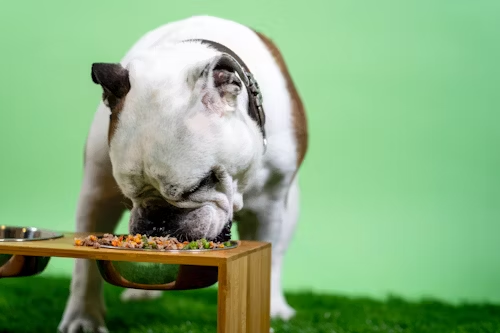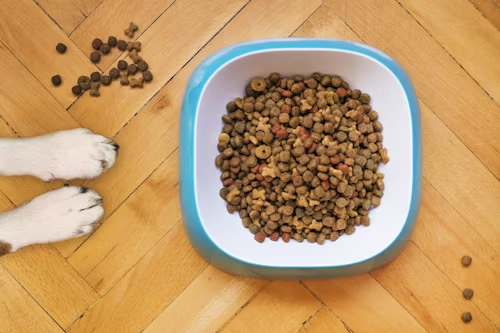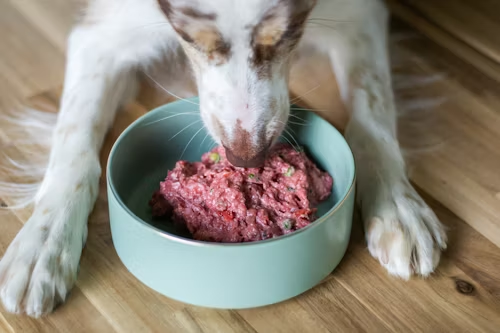If you’ve ever caught your cat sneaking a few bites from your dog’s bowl, you’re not alone. Many pet owners have wondered: Can cats eat dog food?
The short answer is a little dog food won’t harm your cat, but feeding it regularly is not safe or healthy. Cats and dogs may live together and share your attention, but their nutritional needs are completely different.
In this article, we’ll explain why cats shouldn’t rely on dog food, what happens if they do, and how to keep both pets healthy and happy.
Understanding the Basics that Cats and Dogs Are Not the Same
Cats are obligate carnivores, meaning they must eat meat to survive. Their bodies are designed to extract nutrients from animal protein, not plants.
Dogs, on the other hand, are omnivores. They can eat both plant-based and animal-based foods. This difference explains why feeding your cat dog food isn’t a good idea; what works for dogs doesn’t meet the nutritional demands of cats.
Why Cats Need Meat (and Lots of It)
Cats rely on several key nutrients that are either missing or present in very low amounts in dog food. These include taurine, arachidonic acid, vitamin A, and high levels of protein.
1. Taurine
Taurine is an amino acid that cats cannot produce on their own. It supports healthy heart function, good vision, and normal digestion. It’s also essential for reproduction and overall vitality.
Dog food contains little to no taurine because dogs can produce it naturally. Without enough taurine, cats can suffer from heart disease (dilated cardiomyopathy) and even blindness.
2. Arachidonic Acid
Arachidonic acid is a type of fatty acid necessary for cats’ skin health, immune function, and reproduction. Dogs can make it in their bodies, but cats cannot, so they must obtain it from animal fat. Dog food rarely contains enough of it.
3. Vitamin A
Cats cannot convert beta-carotene from plants into vitamin A like dogs can. They need pre-formed vitamin A from animal sources. Dog food typically contains vitamin A in forms cats cannot use effectively.
4. Protein
Cats require much higher levels of protein compared to dogs. Dog food is designed for omnivores, so it contains more carbohydrates and less protein. Feeding a cat dog food long-term can lead to muscle loss and poor organ function.
Why Cats Are Attracted to Dog Food Anyway
If dog food is not good for them, why do some cats seem to love it? However, just because a cat enjoys the taste doesn’t mean it’s good for them. It’s like humans craving junk food—enjoyable, but not nutritious. There are a few reasons:
- Curiosity: Cats like exploring new smells and textures.
- Imitation: Cats may copy their canine companions when they see them eating.
- Hunger or boredom: If a cat’s own meal is delayed, they might snack on whatever is available.
What Happens If a Cat Eats Dog Food Regularly
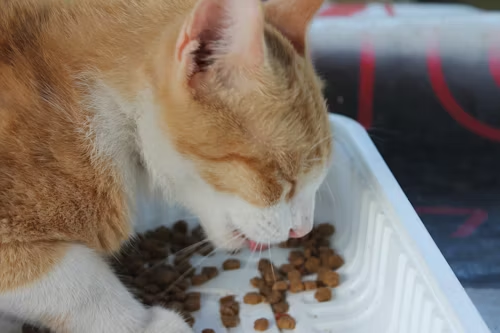
A small bite now and then won’t cause harm. But if a cat eats dog food regularly, it can lead to nutritional deficiencies and health problems over time.
1. Taurine Deficiency
One of the biggest concerns when cats eat dog food too often is a lack of taurine. Taurine is an amino acid that’s absolutely vital for cats; it helps keep their hearts strong, their vision sharp, and their bodies functioning properly.
Since dogs can make taurine on their own, most dog food doesn’t include much of it. Without enough taurine, cats can develop heart disease, experience vision loss, and become unusually tired or weak. It’s a slow, silent problem that often goes unnoticed until the symptoms become serious.
2. Vitamin Deficiencies
Dog food also lacks certain vitamins that cats depend on. For instance, cats need preformed vitamin A, which comes from animal sources. If they don’t get enough, you might notice their fur becoming dull, their skin dry, or their night vision worsening.
They can also become deficient in nutrients like niacin and arginine, which can lead to appetite loss, weight reduction, and general fatigue. These deficiencies build up gradually, which is why feeding dog food long-term is risky even if your cat seems fine at first.
3. Protein Deficiency
Protein is the foundation of a cat’s diet. Cats are natural carnivores, and they need more protein than dogs do to maintain muscle strength, energy, and a healthy immune system. Dog food is designed for omnivores, so it typically contains lower protein levels and more carbohydrates.
Over time, that imbalance can cause muscle weakness, sluggishness, and, in the case of kittens, slowed growth and development. In short, it’s not enough to keep your cat’s body in peak condition.
4. Digestive Problems
Cats’ digestive systems are built to process meat efficiently, not grains or plant-based fillers. Because dog food often contains more fiber and carbohydrates, cats can struggle to digest it properly. This may result in mild stomach upsets such as vomiting, diarrhea, or gas.
Some cats might even experience bloating or discomfort after eating it. While these symptoms might seem minor at first, they can become chronic if the cat keeps eating the wrong type of food.
5. Long-Term Organ Stress
Finally, there’s the issue of organ health. When a cat’s diet doesn’t include the nutrients their body requires, their organs have to work harder to compensate. Over months or years, this can strain the liver, kidneys, and heart.
The result might be chronic health conditions that are difficult—and expensive—to manage later on. In other words, what starts as a seemingly harmless habit can eventually shorten your cat’s lifespan.
What to Do If Your Cat Eats Dog Food
If your cat eats a small amount of dog food, don’t panic. It’s usually harmless. Follow these steps to be safe:
- Remove any remaining dog food so your cat can’t eat more.
- Offer your cat fresh cat food and water.
- Observe your cat for any signs of vomiting, diarrhea, or fatigue.
- If your cat ate a large quantity or has an existing medical condition, call your veterinarian for professional advice.
How to Stop Your Cat from Eating Dog Food
Managing multiple pets can be challenging, especially when they share space. Try these strategies to prevent food stealing:
1. Separate Feeding Areas
One of the easiest ways to stop your cat from sneaking dog food is to feed them in different rooms. Cats usually like to eat in peace and quiet, without noise or movement around them. Giving your cat a private feeding spot like a quiet corner or a closed room; helps them feel secure and reduces the urge to check out what’s in the dog’s dish.
2. Schedule Feeding Times
Leaving food out all day makes it hard to keep your cat and dog out of each other’s meals. Instead, try setting regular feeding times for both pets. Offer their meals at the same time, and once they’re done, pick up any leftovers. This way, neither one has the chance to wander over and eat from the other’s bowl.
3. Use a Cat-Only Feeder
If your cat is especially persistent, technology can help. You can invest in a microchip-activated feeder or an automatic cat feeder that only opens for your cat’s collar tag. This ensures that your cat gets their food when they need it, and the dog doesn’t have a chance to interfere. It’s also great for multi-cat households where one cat might need a special diet.
4. Keep Your Cat Engaged
Sometimes, a cat’s curiosity about dog food isn’t about hunger; it’s about boredom. Cats are smart, active creatures who need both physical and mental stimulation. Try introducing new toys, scratching posts, climbing trees, or food puzzles to keep your cat entertained. When your cat is busy playing and exploring, they’ll be far less interested in what’s sitting in the dog’s bowl.
5. Feed Quality Pet Food
Lastly, make sure both your pets are getting food that meets their unique nutritional needs. Cats and dogs have very different dietary requirements, and when they’re each eating high-quality food made specifically for them, they’ll feel more satisfied after meals. A well-fed cat is much less likely to crave or steal the dog’s food simply because they’re already getting everything they need.
Can Cats Eat Dog Treats?
Dog treats follow the same rule as dog food. A tiny nibble isn’t dangerous, but they shouldn’t be a regular part of your cat’s diet.
Dog treats often contain ingredients like grains, flavorings, and peanut butter that don’t suit feline digestion. They might also include additives that aren’t tested for cats. If you want to reward your cat, choose cat-specific treats or small portions of cooked chicken, turkey, or salmon.
Key Differences between Dog Food vs. Cat Food
| Nutrient or Feature | Cat Food | Dog Food |
|---|---|---|
| Protein | High (meat-based) | Moderate (mixed sources) |
| Taurine | Added | Usually absent |
| Vitamin A | Preformed (animal-based) | Beta-carotene (plant-based) |
| Arachidonic Acid | Required | Not essential |
| Carbohydrates | Low | Higher |
| Taste Preference | Meat-flavored | More variety (meat and plant mix) |
This table shows why cat food and dog food are not interchangeable. Cat food is rich in meat nutrients that cats need daily, while dog food is formulated for a different digestive system.
Can Kittens Eat Dog Food?
Absolutely not. Kittens need even more protein, fat, and nutrients than adult cats to support their rapid growth.
Feeding dog food to kittens can lead to stunted growth, weak bones, and permanent health issues. Always use food labeled “formulated for kittens” and approved by the Association of American Feed Control Officials (AAFCO).
What About Homemade or Raw Diets?
Some owners consider making one homemade diet for both cats and dogs. While this seems convenient, it’s risky without professional guidance. Cats have specific nutrient needs that differ greatly from dogs. If you want to prepare homemade or raw meals:
- Consult a veterinary nutritionist.
- Make sure the diet includes taurine, arachidonic acid, vitamin A, and enough protein.
- Avoid raw meats that may contain harmful bacteria.
Veterinarian Advice
Veterinarians agree that dog food is not toxic to cats, but it is nutritionally incomplete for them. Cats that eat dog food over time can develop nutrient deficiencies that lead to severe health problems.
Veterinary nutritionists stress the importance of taurine and protein for cats. Even high-end dog foods do not meet these requirements.
If cost is a concern, your vet can recommend budget-friendly cat food options that still meet AAFCO nutritional standards.
Safe Alternatives and Feeding Tips
- Always feed your cat balanced cat food appropriate for their life stage (kitten, adult, senior).
- You can occasionally add small pieces of cooked meat for variety.
- Keep cat food fresh and served at room temperature.
- Make sure your cat has access to clean water at all times.
Common Myths About Cats and Dog Food
| Myth | Truth |
|---|---|
| “It’s all just pet food; they’re the same.” | Cats need taurine, arachidonic acid, and high protein—nutrients that dog food lacks. |
| “My cat eats dog food all the time and is fine.” | Problems develop slowly; deficiencies may take months to appear. |
| “Feeding both pets the same food saves money.” | Malnutrition can lead to expensive vet bills later on. |
Keep Meals Species-Specific
Cats and dogs might live under the same roof, but they should never share a diet. Dog food might not be poisonous to cats, but it’s not nutritionally designed for them. If your cat steals a bite occasionally, there’s no need to worry. But consistent feeding can cause long-term health problems.
The best way to show love to your pets is by feeding each one food made specifically for their species. A proper diet will keep them healthy, active, and with you for many happy years.
